Dec 17, 2020 | Climate Change, COVID19, Sustainable Development
By Greg Davies-Jones, 2020 IIASA Science Communication Fellow
Greg Davies-Jones finds out how COVID-19 has lightened the carbon footprint of IIASA and uncovers how the institute plans to integrate climate protection and sustainability into everyday research activities.
The impact of COVID-19 has been profound and pervasive, infiltrating deeply into many spheres of society. IIASA has not escaped the clutches of the pandemic either: The phrase ‘unprecedented times’ has become just as commonplace here at the institute as it has across the globe. Despite the overt and all too evident adverse consequences of COVID-19, there is a significant, albeit only temporary, positive aspect of a lockdown existence, namely a reduction in carbon dioxide (CO2) emissions.
At IIASA, the principal decline in CO2 emissions has been due to the drop-off in business travel. With individual mobility heavily restricted, travel arising out of research activities, meetings, and conferences has dropped to almost zero. To fill the void, the virtual world is rapidly becoming the everyday reality: Zoom calls, Skype meetings, audio hiccups, video glitches, and the occasional gallivanting toddler have fast become the norm in this new working world.

Schloss Laxenburg | ©IIASA
In the years to come, when the COVID-19 cobwebs are finally blown away (hopefully), might this new working world become more commonplace? A hybrid between the pre-COVID-19 and post COVID-19 worlds perhaps? One thing is certain: The continuation of business-as-usual will be catastrophic environmentally. A recent climate poll documented in The Guardian found despairingly that people are planning to drive and, in some cases, even fly more in the future than before the coronavirus pandemic. The dangerous inference that could be drawn from this is that, rather than merely a disconnect between individual actions and outcomes, there are conscious choices being made that are increasingly recognized as being highly inimical to the continued existence of most life forms on this planet.
Given the global shock to the economy, cost will also be a key factor influencing decisions in the post COVID-19 world. Virtual conferencing is pre-eminently a cheaper alternative. Although not a perfect substitute for in-person meetings – it does come with advantages (e.g., lower resource requirements and better accessibility) as well as disadvantages (e.g., lacking informal exchanges).
“Another aspect is inclusivity ̶ virtual conferencing affords people the opportunity to engage with relative ease (provided they have a sound internet connection), irrespective of their geographical location,” explains IIASA researcher Caroline Zimm.
Fellow researcher, Benigna Boza-Kiss, continues: “The virtual working world can be fruitful and effective, but we must be more strategic in how it is organized. Structured meetings with specific objectives planned in advance will allow for ineffectual activity and call-times, which similarly generate emissions, to be reduced.”
Notwithstanding these positives of a virtual working environment, there are some apprehensions, particularly regarding the impossibility of virtual platforms to meaningfully replicate certain types of social interactions, including those that occur outside structured sessions at conferences. Conversations beside the coffee machine, chinwags in the corridor, or even the post-work evening revelry – all such serendipitous moments and gainful interaction are considered invaluable in providing the ‘complete’ conference experience. Yet, the virtual world can offer other distinct advantages.
“In video calls and online conferencing platforms, it is not as daunting to ‘raise a hand’ or contact someone more senior. I have found that some people actually speak up more (often using the chat function) than they would in a physical conference setting. This means a shift in the networking dynamic and perhaps even greater inclusivity,” says Zimm.
The lightening of the carbon footprint of IIASA research ventures will likely be short-lived unless we make fundamental changes over the long-term. As the time window in which we can effectively act on climate change inexorably closes, it is imperative that we do more to attain the universal climate goals written into the Paris Agreement.
In light of this challenge, and considering the work of IIASA as a leader in environmental and sustainability studies, it feels appropriate to ask: Should the prevailing ethos of environmental institutes and practitioners therein openly acknowledge and embrace the responsibility to act as role models in reducing negative environmental impact? Put bluntly, should it be incumbent upon them to ‘walk the talk’? Are people more likely to respond to organizations and researchers that practice what they preach?
Many environmental institutes and researchers, at least nominally, would agree, but this purported espousal must be underpinned by concrete action. In 2019, IIASA joined forces with Climate Alliance Austria – an organization focusing on awareness-raising projects and activities to promote knowledge on climate issues and sustainable development. The IIASA-Climate Alliance mandate is to integrate climate protection and sustainability into everyday research.
To advance this philosophy, IIASA has formed an internal Environment Committee that focuses on nurturing more environmentally friendly processes and activities at the institute. To this end, the committee has organized an evaluation and is elaborating a strategy that includes developing Green Event Guidelines, powering IIASA with certified green electricity, and encouraging individual action with a ‘Bike to Work’ scheme.
For the most part however, these are all fledgling initiatives that require cultivation, top level support and leadership to ensure success. Moreover, these initiatives necessitate additional targeted and hard-hitting emission-mitigation strategies to avoid frustratingly commonplace ‘greenwashing’ and ensure decisive, positive internal climate action. More stringent measures, such as the institute’s proposed stricter sustainable procurement and travel policies, will arguably make a powerful and lasting contribution to this over-arching aim of “reconfiguring” IIASA as an employer that is doing all it can to implement and facilitate sustainable working practices for its entire workforce.
Note: This article gives the views of the author, and not the position of the Nexus blog, nor of the International Institute for Applied Systems Analysis.
Aug 19, 2020 | Climate Change, COVID19, USA, Wellbeing, Young Scientists
By Lisa Thalheimer, 2020 IIASA Young Scientists Summer Program (YSSP) participant in the Risk and Resilience and World Population Programs
Lisa Thalheimer shares her journey in researching climate-related migration in the age of the COVID-19 pandemic and the importance of taking mental health issues into account in climate science and the policy realm.

© Raul Mellado Ortiz | Dreamstime.com
COVID-19 has changed our idea of normal. These unprecedented, stressful times affect us all – some of us more than others. Fear and anxiety over a new disease without any promise of a vaccine anytime soon, global economic downturn, along with feelings of loneliness and emotional exhaustion due to the lockdown, can leave us mentally exhausted. Rates of depression and addiction-related suicide are in fact already on the rise among young people like myself.
Now imagine you are advised to stay at home, but you cannot do so because climate change has turned your entire life upside down: your house is no longer there, you have lost your job, your family or friends – you are likely to feel unhinged. This is a reality for many migrants across the globe. It is inevitable that existing migration patterns will be shifted beyond disasters alone. Cascading impacts form the still unfolding pandemic could compound. No matter if you are a migrant yourself or not, agency and the choice over the decision whether to leave your house or not, and the luxury to socially distance could potentially not be an option with a systemic shock like COVID-19.
These changes in circumstances have also affected me as a young scientist. I would have been in Laxenburg, getting to know my YSSP peers and IIASA colleagues, but this year’s journey has been rewritten – courtesy of the COVID-19 pandemic.
I was living in Oxford in the UK when I came to realise that mental health is a game changer in the way I manage my day, make decisions, my ability to care for my partner who suffers from Amyotrophic Lateral Sclerosis (ALS), and making progress on my PhD thesis. Everything felt more difficult. I was overwhelmed. I wanted to understand why this is the case. My interest soon evolved into researching the links between mental health and my PhD topic of climate-related migration.
For the article “The hidden burden of pandemics, climate change and migration on mental health”, I teamed up with an epidemiologist who specialises in mental health at my old university home, the Earth Institute in New York City. This research experience was an eye-opener, both personally and scientifically.
In our article, we focused on the US, as it has been hit hardest by COVID-19 – in mid-August, the number of COVID-19 cases exceeded five million. On top of this, depression and anxiety are already prominent among Americans, as is costly impacts from disasters. Hurricanes cost the US around US$ 17 billion every year, but estimates show a higher probability of extremely damaging hurricane seasons with climate change. We may know the impact of climate change on assets and on physical health, but what about mental health impacts?

© Raggedstonedesign | Dreamstime.com
Although my coauthor and I come from different scientific disciplines, I soon came to realize that our scientific approach has a common denominator: systems thinking. Accounting for interconnections and cascading effects, our article shed light on different systems affected by COVID-19 and situations where mental health issues are likely to become increasingly prevalent in a changing climate. The article focuses on already vulnerable parts of the population, for example those who have been impacted by Hurricane Katrina or Hurricane Harvey – the latter of which has been made worse by climate change. The article illustrates how COVID-19 becomes a risk multiplier for climate migrants in three distinct case studies: key workers in New York as urban setting, seasonal migration dynamics, and disproportionate effects on black and Latino communities. Unrelenting effects include loss of employment, and a lower likelihood of being able to work from home or to have health insurance than white people.
A better understanding of the mental health-migration-climate change nexus can help absorb adverse mental health outcomes from COVID-19, which would otherwise compound. We however need to tackle systemic risks affecting mental health through synergies in research and policy, and an integrated intervention approach. Free mental health support for key workers through tele-therapy and mental health hotlines provide a practical way forward. Personally, I learned that climate migrants have been relentlessly resilient to systemic shocks. Nevertheless, with mental health issues, it becomes increasingly hard to maintain such resilience. With this commentary, I hope that mental health and interdisciplinary research finds its way in climate science and in the policy realm. We all need a clear mind to attain the Sustainable Development Goals.
Note: This article gives the views of the author, and not the position of the Nexus blog, nor of the International Institute for Applied Systems Analysis.
Aug 14, 2020 | COVID19, IIASA Network, Sustainable Development
By Nebojsa Nakicenovic, Director of The World In 2050 and Emeritus Research Scholar at IIASA
IIASA Emeritus Scholar Nebojsa Nakicenovic explains how the societal disruptions caused by the coronavirus pandemic can offer an opportunity for a more sustainable and innovative future.
While the future of humanity has always been unpredictable, major challenges — like the current pandemic — have been an inevitable part of our shared history. What is different now, however, is that human beings have become the dominant force of planetary change. In other words, the Anthropocene has arrived, and with it an unprecedented opportunity to steer our collective future.
Science, technology, and innovation (STI) are the drivers of this change, and can also be the means of achieving a sustainable, equitable, and resilient future for both human civilization and the biosphere. These tools, however, need to be complemented with the necessary evolutions of our economies, public institutions, and behavioral norms. The rapid rise in inequality and resource consumption over the last few decades, for example, has led to increasing pressure on people and the planet in ways that are clearly unsustainable. It is within this context that the COVID-19 pandemic could become a disruptive event that triggers fundamental change toward a more desirable future for all.
Human history is rich with other instances of rapid social and environmental evolution, from the agricultural turn of the Neolithic Revolution some ten thousand years ago to the explosive changes brought about by the Industrial Revolution two centuries ago. However, it was the ‘great acceleration’ of the last 50 years, characterized by exponential growth of consumption and rapid degradation of planetary support systems, that brought us to the geophysical limits of our home world for the first time. These rapid developments were neither smooth nor pervasive, and were interlaced with many crises, wars and pandemics, natural disasters, and numerous other disruptive events. Yet over the last 200 years we’ve seen a 7x increase in the global population, a 100x increase in economic output, and a 20x increase in carbon dioxide emissions.
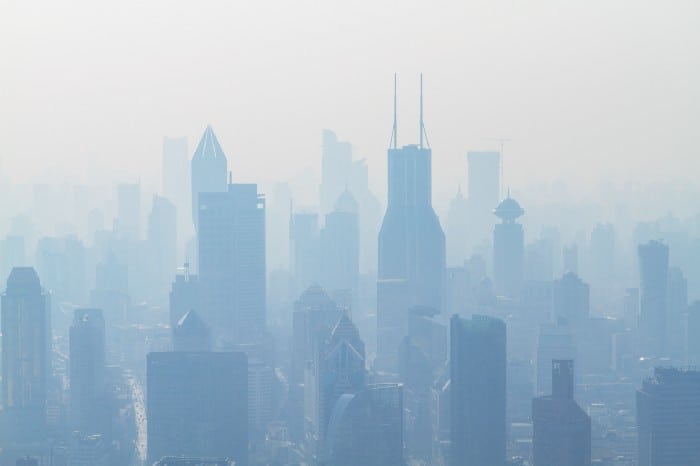
Photo by Holger Link on Unsplash
In the aftermath of major crises that caused deep disruption, loss of life, and the destruction of capital and jobs, a ‘new normal’ eventually emerged — the major depressions of the 1870s and 1930s, as well as the oil crisis of the 1970s, are just three examples among many. Events like these arguably amplified the limits and disadvantages of the ‘old’ and paved the way for the ‘new’, with each crisis catalyzing innovation and the re-direction of human activities towards a fundamentally new direction. Today, we might say that each caused a tipping point that led to new development and behavioral pathways.
The COVID-19 pandemic, one of the greatest threats to human societies in recent memory, can be seen as a similarly catalytic event. While history does not repeat itself, there are many similarities in the response strategies to earlier pandemics such as the Black Plague of the middle ages and the Spanish Flu of the 1920s, including policies of ‘social distancing’ and isolation and barriers of entry to those from ‘outside’. Even the word quarantine (meaning ‘forty days’ in Venetian) was first coined during the plague epidemic of the 14th century.

Photo by Cheng Feng on Unsplash
Today’s crisis, as in the past, has revealed the worst parts of our nature, as with the callous exclusion of the needy, homeless, and migrants from the emerging responses, as well as the hoarding of perceived scarce goods by the well-off. At the same time, the pandemic has brought out some of the best human characteristics: self-sacrifice in helping others, renewed empathy and solidarity, and unprecedented global cooperation within science and between governments as we work to stem the worst of the pandemic.
Moreover, there is mounting evidence that the partial shut-down of the global economy has had demonstrably positive effects on the environment, such as reduced emission levels, lower pollution, and a resurgence in wildlife. While an economic depression is by no means a viable mitigation strategy for climate change and other pressing environmental issues, these data make clear that the right policies and priority investments in STI could have immediate and significant effects in our efforts to transition to a sustainable world.
Many scientists, policymakers, and other stakeholders are already working to leverage this current moment of opportunity into lasting change. The World in 2050, a global research agenda aiming to help reach the United Nations’ Sustainable Development Goals, offers six transformations that outline essential STI, institutional, and behavioral synergies to achieve the new direction for human development while providing critical support for the most vulnerable among us. The Earth Commission, a group of leading scientists convened by Future Earth, is working to underpin the development of science-based targets for systems like land, water, and biodiversity in order to guide companies and cities towards sustainable pathways, as many thought leaders are beginning to reconsider the stability and efficiency of our current economic systems. Thomas Piketty, for example, has recently proposed that every person should receive $120,000 at age of 25 to enable innovative initiatives among those who lack the capital to do so. Bold efforts like these will become increasingly necessary as we work towards a new set of planetary operating parameters that will ensure an equitable and sustainable future for all.
Our response to COVID-19 could help redirect trillions of dollars towards this agenda. While current measures aim to preserve existing institutional and economic arrangements, we should press decision makers to actively channel these funds into the drivers of innovation to bring about the future we want to live in. This deep and ongoing crisis may destroy some of the ‘old’ characteristics of this moment in human history, and could bring about the transformations in sustainability that will enable us to build a better future for all life here on Earth. The risk is that exactly the opposite will happen — and that is a risk that humanity cannot afford to take.
This piece was originally published on Medium and Future Earth.
Note: This article gives the views of the author, and not the position of the Nexus blog, nor of the International Institute for Applied Systems Analysis.
Aug 11, 2020 | COVID19, Data and Methods, Science and Policy, Women in Science
By Sibel Eker, researcher in the IIASA Energy Program
IIASA researcher Sibel Eker explores the usefulness and reliability of COVID-19 models for informing decision making about the extent of the epidemic and the healthcare problem.
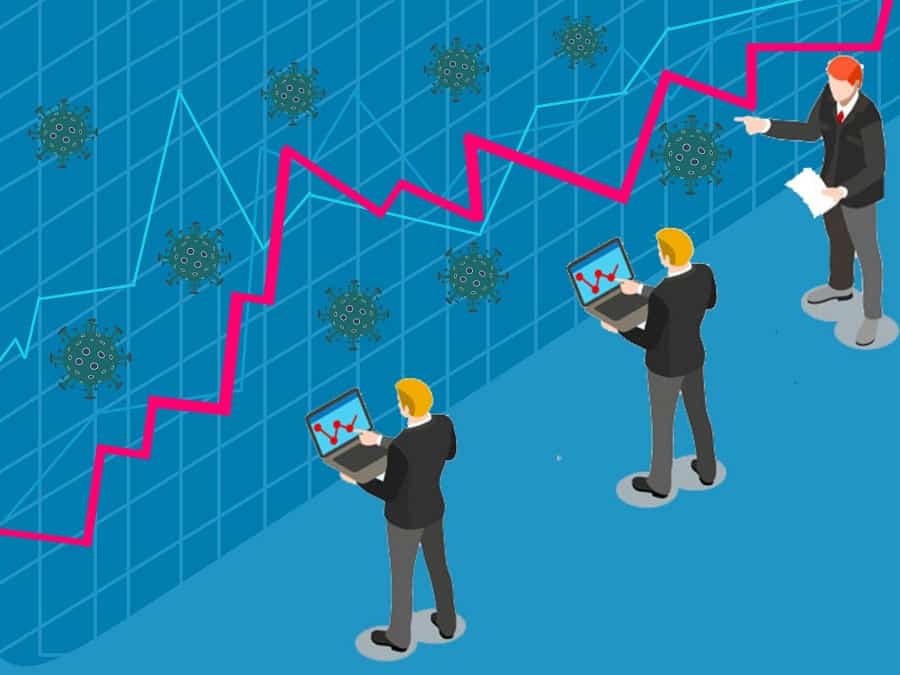
© zack Ng 99 | Dreamstime.com
In the early days of the COVID-19 pandemic, when facts were uncertain, decisions were urgent, and stakes were very high, both the public and policymakers turned not to oracles, but to mathematical modelers to ask how many people could be infected and how the pandemic would evolve. The response was a plethora of hypothetical models shared on online platforms and numerous better calibrated scientific models published in online repositories. A few such models were announced to support governments’ decision-making processes in countries like Austria, the UK, and the US.
With this announcement, a heated debate began about the accuracy of model projections and their reliability. In the UK, for instance, the model developed by the MRC Centre for Global Infectious Disease Analysis at Imperial College London projected around 500,000 and 20,000 deaths without and with strict measures, respectively. These different policy scenarios were misinterpreted by the media as a drastic variation in the model assumptions, and hence a lack of reliability. In the US, projections of the model developed by the University of Washington’s Institute for Health Metrics and Evaluation (IHME) changed as new data were fed into the model, sparking further debate about the accuracy thereof.
This discussion about the accuracy and reliability of COVID-19 models led me to rethink model validity and validation. In a previous study, my colleagues and I showed that, based on a vast scientific literature on model validation and practitioners’ views, validity often equates with how good a model represents the reality, which is often measured by how accurately the model replicates the observed data. However, representativeness does not always imply the usefulness of a model. A commentary following that study emphasized the tradeoff between representativeness and the propagation error caused by it, thereby cautioning against an exaggerated focus on extending model boundaries and creating a modeling hubris.
Following these previous studies, in my latest commentary in Humanities and Social Sciences Communications, I briefly reviewed the COVID-19 models used in public policymaking in Austria, the UK, and the US in terms of how they capture the complexity of reality, how they report their validation, and how they communicate their assumptions and uncertainties. I concluded that the three models are undeniably useful for informing the public and policy debate about the extent of the epidemic and the healthcare problem. They serve the purpose of synthesizing the best available knowledge and data, and they provide a testbed for altering our assumptions and creating a variety of “what-if” scenarios. However, they cannot be seen as accurate prediction tools, not only because no model is able to do this, but also because these models lacked thorough formal validation according to their reports in late March. While it may be true that media misinterpretation triggered the debate about accuracy, there are expressions of overconfidence in the reporting of these models, even though the communication of uncertainties and assumptions are not fully clear.

© Jaka Vukotič | Dreamstime.com
The uncertainty and urgency associated with pandemic decision-making is familiar to many policymaking situations from climate change mitigation to sustainable resource management. Therefore, the lessons learned from the use of COVID models can resonate in other disciplines. Post-crisis research can analyze the usefulness of these models in the discourse and decision making so that we can better prepare for the next outbreak and we can better utilize policy models in any situation. Until then, we should take the prediction claims of any model with caution, focus on the scenario analysis capability of models, and remind ourselves one more time that a model is a representation of reality, not the reality itself, like René Magritte notes that his perfectly curved and brightly polished pipe is not a pipe.
References
Eker S (2020). Validity and usefulness of COVID-19 models. Humanities and Social Sciences Communications 7 (1) [pure.iiasa.ac.at/16614]
Note: This article gives the views of the author, and not the position of the Nexus blog, nor of the International Institute for Applied Systems Analysis.
Jun 15, 2020 | COVID19, Data and Methods, Demography
By Tadeusz Bara-Slupski, Artificial Intelligence for Good initiative leader, Appsilon Data Science
Tadeusz Bara-Slupski discusses the Artificial Intelligence for Good initiative’s recent collaboration with IIASA to develop an interactive COVID-19 data visualization tool.
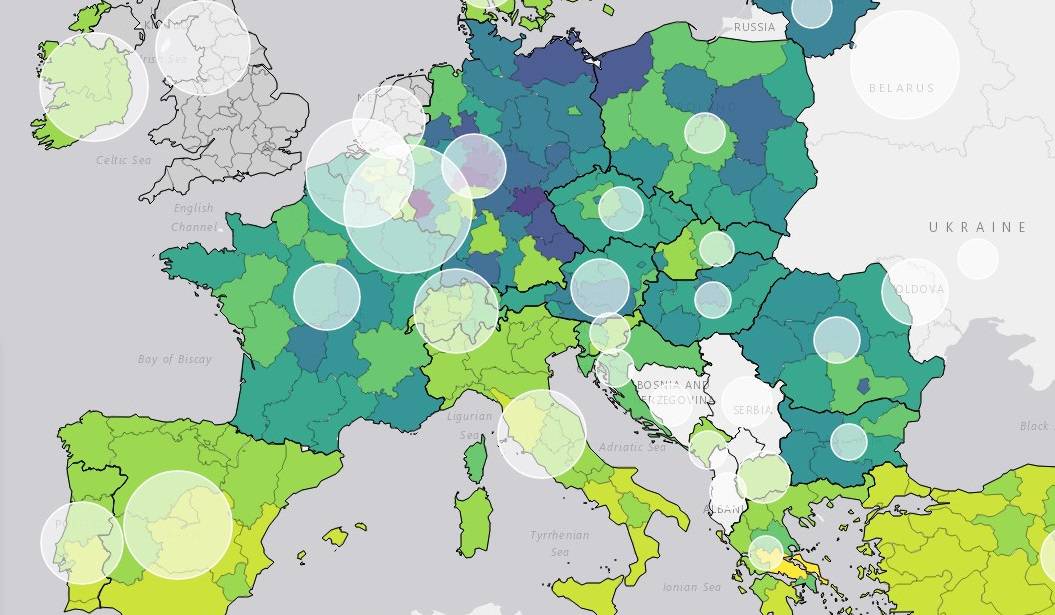
Number of hospital beds per 1000 population © IIASA
Public institutions rely on external data sources and analysis to guide policymaking and intervention. Through our AI for Good initiative, we support organizations that provide such inputs with our technical expertise. We were recently approached by IIASA to create a dashboard to visualize COVID-19 data. This builds on our previous collaboration, which had us deliver a decision-making tool for natural disaster risk planning in Madagascar. In this article, we provide an example of how to help policymakers navigate the ocean of available data with dashboards that turn these data into actionable information.
Data is useful information when it creates value…or saves lives
The current pandemic emergency has put an unprecedented strain on both public health services and policymaking bodies around the world. Government action has been constrained in many cases by limited access to equipment and personnel. Adequate policymaking can help to coordinate the emergency relief effort effectively, make better use of scarce resources, and prevent such shortages in the future. This, however, requires access to secure, timely, and accurate information.
Governments commission various public bodies and research institutes to provide such data both for planning and coordinating the response. For instance, in the UK, the government commissioned the National Health Service (NHS) to build a data platform to consolidate a number of data providers into one single source. However, for the data to be useful it must be presented in a way that is consistent with the demands of an emergency situation. Therefore, the NHS partnered with a number of tech companies to visualize the data in dashboards and to provide deeper insights. Raw data, regardless of its quality, is not useful information until it is understood in a way that creates value – or in this case informs action that could save lives.
IIASA approached us to support them in making their COVID-19 data and indicators more useful to policymakers. The institute’s research is used by policymakers around the world to make critical decisions. We appreciated the opportunity to use our skills to support their efforts by creating an interactive data visualization tool.
IIASA COVID-19 report and mapbook
Research indicates that while all segments of the population are vulnerable to the virus, not all countries are equally vulnerable at the same time. Therefore, there is a need for accurate socioeconomic and demographic data to inform the allocation of scarce resources between countries and even within countries.
IIASA responded to this need with a regularly updated website and data report: “COVID-19: Visualizing regional socioeconomic indicators for Europe”. The reader is introduced to a range of demographic, socioeconomic, and health-related indicators for European Union member countries and sub-regions in five categories:
- Current COVID-19 trends – information about the number of cases and effectiveness of policy response measures
- Demographic indicators – age, population density, migration
- Economic indicators – GDP, income, share of workers who work from home
- Health-related indicators – information about healthcare system capacity
- Tourism – number of visitors, including foreign
The indicators and data were chosen for their value in assisting epidemiological analysis and balanced policy formulation. Policymakers often face the challenge of prioritizing pandemic mitigation efforts over long-term impacts like unemployment, production losses, and supply-chain disruptions. IIASA’s series of maps and graphs facilitates understanding of these impacts while maintaining the focus on containing the spread of the virus.
Our collaboration – a dashboard for policymakers
Having taken the first step to disseminate the data as information in the form of a mapbook, Asjad Naqvi decided to make these data even more accessible by turning the maps into an interactive and visually appealing tool.
IIASA has previously approached Appsilon Data Science with a data visualization project, which had us improve the features and design of Visualize, a decision support tool for policymakers in natural disaster risk management. Building on this experience, we set out to assist Naqvi with creating a dashboard to deliver the data to end-users even faster.
The application allows for browsing through a list of 32 indicators and visualizing them on an interactive map. The list is not final with indicators being regularly reviewed, added, and retired on a weekly basis.
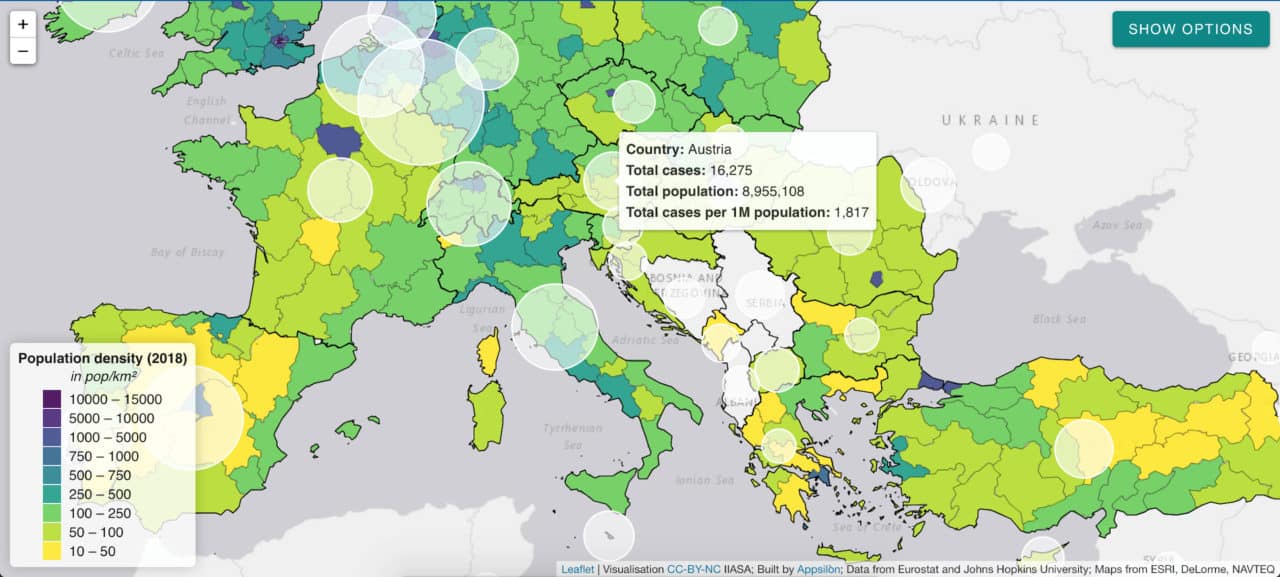
White circles indicate the number of cases per 1 million citizens.
The application will continue to provide the latest and most relevant information to track regional performance in Europe also in the post-pandemic phase:
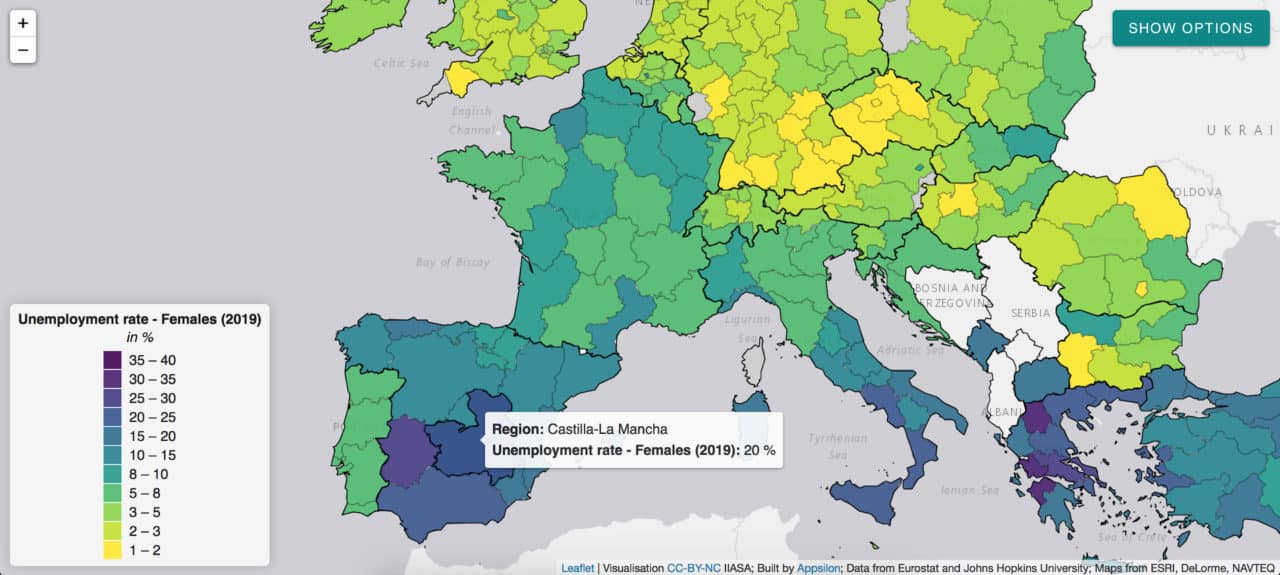
The pandemic has a disproportionate impact on women’s employment and revealed some of the systemic inequalities.
Social distancing measures, for instance, have a large impact on sectors with high female employment rates. The closure of schools and daycare facilities particularly affects working mothers. Indicators such as female unemployment rate can inform appropriate remedial action in the post-COVID world and highlight regions of special concern like Castilla-La-Mancha in Spain.
Given the urgency of the pandemic emergency, we managed to develop and deploy this application within five days. We believe such partnerships between data science consultancies and research institutes can transform the way policymakers utilize data. We are looking forward to future collaborations with IIASA and other partners to help transform data into accessible and useful information.
This project was conducted as part of our Artificial Intelligence for Good initiative. The application is available to explore here.
Note: This article gives the views of the author, and not the position of the Nexus blog, nor of the International Institute for Applied Systems Analysis.
Jun 5, 2020 | COVID19, Demography, Health, IIASA Network
By Tomas Sobotka, Wittgenstein Centre for Demography and Global Human Capital (Univ. Vienna, IIASA, VID/ÖAW), Vienna Institute of Demography
Does COVID-19 affect men and women differently? Tomas Sobotka sheds light on the demographics of the coronavirus pandemic in Europe.
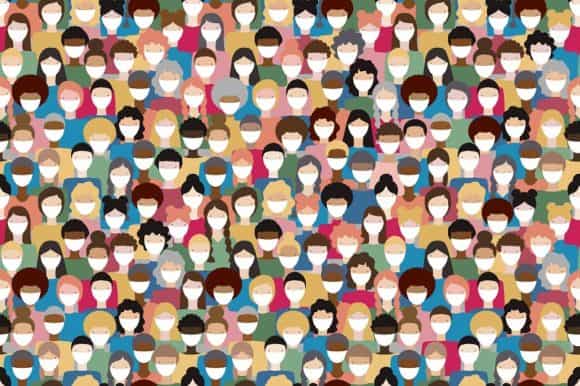
© Florin Seitan | Dreamstime.com
A question from a Time magazine article has a clear underlying message: “Why is COVID-19 striking men harder than women?” By now, everyone has learned that men are more vulnerable to COVID-19 and, if infected, they tend to die much more often than women.
Are men however also more likely to get infected? On the face of it, the number of infections by gender suggests an almost perfect gender equality. Women represent on average 47% of all infections in 70 countries reporting the number of cases by sex, as listed in the online data tracker by Global Health 5050.
Case settled? Not quite yet. The aggregated total number might be deceiving. To understand an underlying story, one has to dig into the age and sex components of total infections. The overall balance of COVID cases by gender is an outcome of age- and sex-specific patterns of infection rates and the actual age- and sex composition of the population. This in turn, is often gender-unequal, especially at older ages, due to excess mortality among men and higher longevity of women.
In fact, in ten European countries I examined with colleagues from the Wittgenstein Centre for Demography and Global Human Capital, including Raya Muttarak from the IIASA World Population Program, it turns out that infection rates are highly gendered, especially when looking at the age pattern of coronavirus infection. From the teenage years up until their late 50s, women are more likely than men to be infected with COVID-19. Women in their 20s display the biggest gender gap in infections: on average only 64 men were infected per 100 infected women aged 20-29. After age 60, the pattern reverses, as infection rates among women drop at age 60-69 and the male infection rates go up or stay stable. This crossover is also clearly visible in the charts for Belgium, Czechia, Germany, and Italy. Between ages 60 and 79, men are more likely than women to be infected. The imbalance is sharpest among people in their 70s, with an average of 136 infected males per 100 infected women. This puts older males at a double disadvantage: they are more likely to be infected and, once infected, they are much more likely to die (with both higher age and being a male identified as important risk factors).
Is our evidence credible? Clearly, many infections are undetected and our data are affected by different testing availability and testing priorities across countries. It is possible that women of working age get more frequently tested than men as women tend to be more concerned about their health. This would bias the estimated share of infected women upwards. However, the remarkable regularity in the age- and gender-pattern of infections in the analyzed countries suggests that the observed gender disparities are real. The same gender disparity by age is observed in Czechia, Denmark, Germany, and Norway with relatively few infections, as well as in Belgium, England, Italy, and Spain with high numbers of reported infections. Of course, countries differ in their gender imbalance, especially at younger ages: the gender gap is, well, gaping, in Belgium, which reports only 34 infected men per 100 infected women at age 20-29. It is much smaller in Czechia, Germany, and Norway, but the female dominance at young ages and the male dominance at older ages, with a crossover around age 60, is consistently found in each society we studied.
What’s the likely explanation? At younger ages, the smoking gun points at women’s employment and occupations. Most women of working age in Europe are employed. This may also partly explain why European countries actually register a higher number of infections among women than most other countries, with an average share of 55%. More importantly, women are often working in professions that are most exposed to the infection. Think of nurses, medical doctors, other healthcare professionals, but also all the care workers in retirement homes, which turned out in some countries to be the focal points of infection. The switch in gender balance occurs right around the retirement age. The higher likelihood of infection among older men is probably linked with their poorer health and lower immunity.
If employment is potentially risky for women, staying at home with children—itself a product of ingrained gender inequalities in work and care—may lead to fewer infections. In countries where women’s employment dips after age 30 due to their extensive parental leaves, infection rates often show a distinct dip after that age as well, going up again in their 40s: Czechia, Germany, and partly Norway and Switzerland show such an M-shaped pattern of infection rates among women.
Even though the fatality rates of women below age 60 are low, engagement in care-work poses a higher risk to healthcare workers and care-home staff. This factor should be included in the ongoing discussions on the impact of COVID-19 on women’s health and wellbeing.

COVID-19 infection rates by age and sex per 1,000 population (solid line for females, dashed line for males, left-hand axis) and the relative M/F ratio in infection rates by age in four European countries
This blogpost is based on the following paper:
Sobotka T, Brzozowska Z, Muttarak R, Zeman K, & di Lego V (2020). Age, gender and COVID-19 infections. medRxiv 2020.05.24.20111765. DOI: https://doi.org/10.1101/2020.05.24.20111765
References
Global Health 5050. COVID-19 sex-disaggregated data tracker. https://globalhealth5050.org/covid19/ (accessed May 18, 2020)
Ducharme J. Why Is COVID-19 Striking Men Harder Than Women? Time, 1 May 2020. https://time.com/5829202/covid-19-gender-differences/
Note: This article gives the views of the author, and not the position of the Nexus blog, nor of the International Institute for Applied Systems Analysis.













You must be logged in to post a comment.